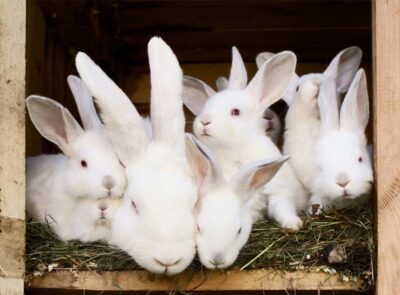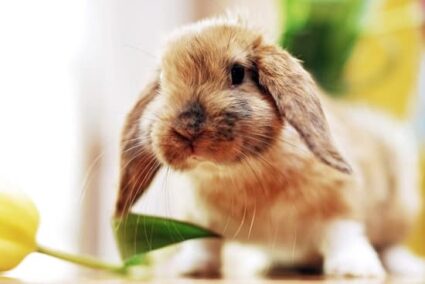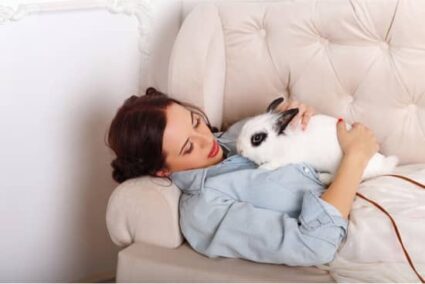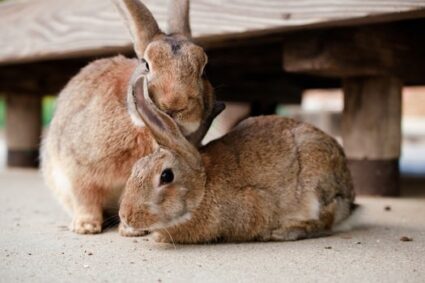Rabbits are considered quiet pets, but don’t be fooled. Rabbits communicate with each other, and their owners, all the time. They don’t need to make loud noises to convey their message.
There are verbal communications that all rabbits understand. Grunting means, “leave me alone,” and honking is a mating call. Rabbits also communicate using their bodies. Rabbits live by a strict code of hierarchy, and grooming plays a key role in this.
Such tactile nature also plays into peacemaking, as rabbits apologize by touching faces. This guide looks closely at the communication methods of rabbits, both verbal and physical.
Do Rabbits Verbally Communicate with Each Other?
A rabbit’s primary form of communication is through body language. Bunnies usually inform each other how they’re feeling through silent cues. These can look strange to humans, but makes sense to another rabbit.
Sometimes, rabbits use verbal communication with each other. Their body language cues may be ignored, and the bunny is reacting with anger. Alternatively, the rabbit may not wish to leave any space for misinterpretation.
My Rabbits Keep Grunting at Each Other
A grunt is the most common rabbit verbalization. Bunny owners will be familiar with this sound. They’ll hear it when doing something the rabbit disapproves of, such as cleaning their hutch.
A grunt from a rabbit translates as, “back off.” As bunnies are very territorial, they’ll grunt at another rabbit that encroaches on their territory. If the other rabbit doesn’t retreat, a fight is likely to break out.
If two rabbits continually grunt at each other, don’t make them share a hutch. They have yet to bond, and both consider themselves the pack alpha. Hierarchy is essential to rabbits, so ignore this at your peril.
My Rabbits Keep Honking at Each Other
Another critical inter-rabbit verbal cue is honking. This sound will start small, and steadily build. You’ll often hear it in bunnies that have not been spayed or neutered. This is because honking is a rabbit’s mating cry.
Think of a honk as a rabbit gauging interest from a bunny of the opposite sex. If the honk is returned, further formalities will be skipped. The bunnies have agreed that mating will happen.
If the honk met with a grunt, the initial rabbit might back away. It depends on how brave they’re feeling. If they ignore the disinterest, they may start circling the other bunny. This means the rabbit is picking their moment to start mounting.
Rabbit Body Language When Communicating with Other Rabbits
Body language is more important to rabbits than verbalization. Although rabbits have better hearing than eyesight, they convey their mood through silent cues. Bunnies instinctively read these.
The ears of a rabbit are among their most expressive feature. If their ears are straight up, and they’re frozen to the spot, something has their interest. Usually, they’re deciding if this is a threat.
If your rabbit starts thumping their foot after adopting this position, they’re frightened. Thumping is a vital part of inter-rabbit communication. As wild bunnies live underground, they thump their foot to warn of impending danger.
Another component of rabbit body language is lying down, with their head on the ground. This is very important to two bunnies that have established their alpha and beta dynamic.
As Action for Rabbits explains, this can be confusing to human eyes. Submissive rabbits adopt this pose in front of their alpha. They are saying, “I acknowledge that I rank lower in the hierarchy.”
Despite this, dominant rabbits also assume with the same position. Their meaning differs, though. This is a demand for grooming, which should start immediately. Grooming is how bunnies show respect for the chain of command.
If two rabbits have found their places, there will be no confusion, and they will get along. Until such a time, they should not live together. Both bunnies will be locked in a battle for supremacy, continually attempting to assert dominance.
How Can I Tell Which of My Rabbits is Dominant?
Once the dominant rabbit in a home has been established, life will be harmonious. You’ll easily tell which of your bunnies is king of the metaphorical castle. Just watch their grooming habits.
A dominant rabbit will spend most their day being groomed by their subordinates. They’ll occasionally return the favor, but far less frequently.
If the grooming lasts a prolonged period of time, the relationship is established. The dominant rabbit will be able to demand grooming on cue. The submissive bunny will comply, and not cease until they’re told.
If the grooming is very short-term, the alliance is still tentative. The submissive rabbit may begrudgingly accept their role, but still have designs on alpha status. This means they may make a later play for dominance.
How Do Rabbits Establish Dominance?
Rabbits may be cute and cuddly to look at, but they can be vicious. Until alpha status is determined, rabbits engage in physical confrontations until one of them yields.
The most common example of this is mounting. If you find one rabbit mounting another without honking, it has nothing to do with mating. The bunny is staking a claim for alpha status.
How the other rabbit responds to this is critical. Some bunnies accept it. The roles are then set between alpha and beta. Just be mindful of false pregnancies, which can result from inter-gender mounting or carrying hay in their mouth to build a nest.

What’s more likely is that the other rabbit will not take kindly. They’ll fight back, using teeth and claws. They may even tear fur from the mounting rabbit’s body. This is known as barbering, and must be discouraged.
Watch your rabbits carefully, and observe their body language. We cannot stress this enough – unbounded bunnies should not share a hutch. They are too territorial as a species for this to work.
Instead, wait for the rabbits to click and establish a happy dynamic. From there, they will live together happily. In fact, they would not be without each other.
How Can I Tell if Two Rabbits Get Along?
We have established that two (or more) rabbits should not share space until they have bonded. This begs the question of how you know this. The answer comes from observing their body language.
Set up a playpen or similar enclosure, and place the rabbits inside it. This should be in neutral territory, which neither bunny has visited and claimed as their territory.
Watch the rabbits carefully, and look for signs of positive interaction.
- No interaction at all is fine, at least at first. No news is good news. If the rabbits are content to ignore each other, that’s a good start.
- Sitting, or lying, side by side. This is an excellent sign. It means the rabbits are willing to share territory.
- Rolling on their back or side. This means that the rabbit is relaxed. They’d never be so tranquil if they feared or distrusted the other bunny.
- If the rabbits keep their feet flat and push their nose and ears forward, they’re intrigued. This is usually a precursor to a friendly interaction.
- Grooming each other. This is a critical part of the rabbit bonding process. Rabbits that harbor aggression toward each other will not exchange grooming.
Keep introducing the rabbits in this setting, increasing the length of exposure each time. If they remain tranquil, you can rest assured that they’ll get along.
This means they’ll trust each other sufficiently to communicate non-verbally in the future. In turn, this means that they can live together in a shared hutch.
When to Separate Two Rabbits
If two rabbits start to show aggression toward each other, they must be separated. Things can escalate quickly in a rabbit disagreement. What’s more, bunnies hold grudges.
Don’t sleep on any of these actions. Separate the rabbits, and give them both a cooling-off period before attempting reintegration.
- Grunting. This is a key warning from rabbits. If the grunt becomes a growl, act even faster.
- Mounting. This is unlikely to be well received by the rabbit on the receiving end.
- Chasing. This may look like a game, but rabbits chase with the intent of biting each other.
- Fighting. Fighting with teeth and claws must be immediately stopped.
Once the rabbits are reunited, keep a close eye on them. They may pick up where they left off. Alternatively, if you’re fortunate, one of both bunnies will instigate an apology.
How Do Rabbits Say Sorry?
Rabbits apologize by touching noses. They may even rub noses. It’s adorable to watch. They will also attempt to use this body language on other pets.

If the bunnies are sufficiently bonded, the apology will be accepted. This may take a while, though. Rabbits are stubborn animals. They can keep up a sulk for days if they feel aggrieved.
You’ll know if the apology is accepted, as both rabbits will hold their position. If one gets up and walks away, they’re still annoyed. It’s best to keep the rabbits separate until their issues are resolved.
How Do Rabbits Communicate with Their Babies?
Rabbits have a reputation as not caring about their babies. This is unfair. Rabbits keep their young safe before they gain independence at a young age.
Baby rabbits are blind and deaf for the first few days of their life. This means that they cannot be communicated with. Thankfully, they’re born with survival instincts. They stay in their nest, made by the mother rabbit while pregnant.
Typically, a rabbit will only feed her babies once a day, for around five minutes. This sustains them for approximately 24 hours. Other than this, the babies will be left alone.
This is the mother rabbit protecting her young, in her own way. Once she had built them a nest, she keeps her distance. This is so, if a predator detects her scent, they will not find her babies.
Once the rabbits reach three weeks, they start eating solids and weaning themselves off milk. After this, their mother will have little to do with them. They may play together, but they will not be taught any particular behaviors.
This is why every rabbit is different and unique. Their personality is a result of nature, and little to do with nurture.
How Do Rabbits Communicate with Humans?
Of course, domesticated rabbits do not need only need to communicate with each other. They need to be able to share their wants and needs with their human owners too.
Just like their interaction with other rabbits, body language cues are essential. It’s pivotal that you learn what your rabbit is thinking by their non-verbal cues. Despite this, rabbits will make more noise around their humans than each other.
Spend as much time with your rabbit as possible when you first bring them home. It’s possible to have conversations with a bunny, despite them not speaking English.
Verbal Rabbit Cues to Humans
Rabbits do have a range of verbal communications that they use around humans. Sometimes these are deliberate, and on other occasions they’re involuntary.
Grunting means that you are doing something that annoys your rabbit. You may hear this when you pick them up, for example. Many rabbits tolerate handling, but do not enjoy it. Grunting is their way of announcing this. They may also snort.
Your rabbit may also grunt when you clean their cage. You are invading their territory, and destroying the beautiful, chaotic mess that they’ve made.

A rabbit whimper is a sound of discomfort or mild fear. Many rabbits whimper when they don’t want to be held. Your bunny may also whimper if they don’t feel safe around their hutch mate. Check a whimpering bunny for signs of injury, too.
Hope that this whimper never becomes a scream. A rabbit screaming, which sounds a lot like a child, means they fear for their life. It’s thankfully an infrequent sound, but it’s never something to ignore.
Not all rabbit sounds are unhappy. A content rabbit will purr. You’ll hear this sound while petting a bunny. Rabbits purr by tapping their teeth together. Don’t mistake this for tooth grinding, which suggests your bunny is in pain.
Happy rabbits also cluck. This means that they’re enjoying a tasty snack. If your rabbit clucks when you offer a treat, it’s a favorite.
Rabbit Body Language Cues to Humans
Of greater importance than verbal cues is a rabbit’s body language. You can tell everything you need to know about your rabbit just by looking at them.
- A rabbit will nudge you with their nose. If they lay their head on the floor, they are requesting – or demanding – petting and grooming. If not, they may just be hungry.
- Rabbits standing on their hind legs and touching you are begging. They may also stare into your eyes. This bunny is being cute, and they know it. This is unlikely to cease until you offer a raisin or similar treat.
- If your rabbit turns their back on you, you have offended them. Some rabbits will refuse to even look at you, pulling their ears over their eyes. This means that you have some making up to do.
- Binkying – jumping and twisting in the air – is an expression of pure joy. Your rabbit likely wants to play. This is a rare, but undeniable, expression of love and affection.
If you don’t act on what your rabbit is trying to tell you, you’ll soon know it. Rabbits often give very gentle nips to humans. This isn’t usually a display of aggression. It’s just a way of making sure they have your attention.
Remember, rabbits are territorial. They may also nip to inform you that you’re in their way. Alternatively, they may be growing angry. This needs to be managed carefully.
You can tell a lot from your pet’s ears. They may also grunt, growl, or even hiss.
- Ears that are pointing sideways and starting to move backward are a warning. The rabbit may also grunt at this point. Stop whatever you’re doing. It’s annoying your bunny.
- Ears standing to attention and pointing backward means that your rabbit has had enough. They are growing increasingly frustrated with your inability to read their cues.
- Ears lowered straight backward, touching your rabbit’s spine, suggest that an attack is imminent. Expect to be bitten or clawed if you don’t move away.
An angry rabbit may seem amusing at first, but it can lead to severe problems. Fortunately, bunnies can often be easily soothed. A groom and a little petting often will often diffuse a tense situation.
Rabbits are far from the noisiest pets in the world, but they’re among the most expressive. Just because your bunny is quiet, it doesn’t mean they’re emotionless. They’re expressing a great deal without making a sound.
If you master this communication, you’ll have a long-lasting and positive relationship with a pet bunny. Most rabbits instinctively know what they’re saying to each other. It’s your responsibility to learn their language for yourself.

